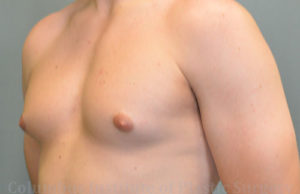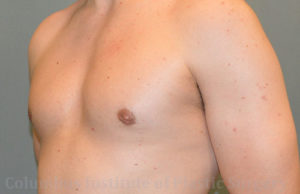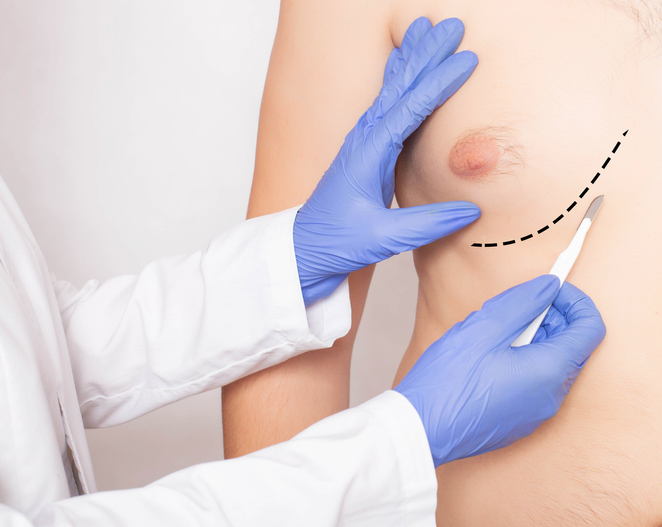Gynecomastia Columbus
An increasing number of men who want to eliminate the appearance of excess breast tissue are seeking gynecomastia (male breast reduction) surgery with Dr. Bivik Shah at the Columbus Institute of Plastic Surgery. Because physical appearance is so important in professional and social circles, plastic surgery is playing a larger role in aesthetic enhancement for men.
Gynecomastia treatment is one of the most common male plastic surgery procedures at Dr. Shah’s office, serving Dayton and Columbus, Ohio.
WHAT IS GYNECOMASTIA?
Gynecomastia is the medical term for enlarged male breasts. This can be at all levels, from a small amount of excess tissue that makes it difficult to wear a tight shirt or go shirtless, to very large amounts of tissue that make male breasts look much like female breasts.
If you would like to speak about gynecomastia surgery and what it can do for you, contact Dr. Shah to speak with him at his Columbus, Ohio office.




View Gynecomastia Gallery
JUMP TO:
- Gynecomastia Surgery – A Solution for Excess Male Breast Tissue
- The Causes of Gynecomastia
- Gynecomastia Surgical Choices
- Risks of Gynecomastia Surgery
- FAQ – Gynecomastia
- Drugs Associated with Gynecomastia
Gynecomastia Surgery – A Solution for Excess Male Breast Tissue
Gynecomastia is a very common problem among men. Excess male breast tissue often develops during puberty. Usually, gynecomastia naturally resolves soon after puberty. For some males, however, the excess breast tissue does not dissipate, and it becomes permanent. Once the tissue becomes permanent, gynecomastia plastic surgery is the only option to reduce the breast size.
Dr. Bivik Shah serves patients from Columbus, Dayton, and other parts of Ohio with his expertise in the removal of male breast tissue. If you are a man with gynecomastia, you probably have tried everything from weight loss to chest exercises, and you have probably found that your efforts did not help to reduce the size of your enlarged breasts. This is because, when you lose weight, you are only losing fat.
Gynecomastia does not result from fat. In fact, many patients considering plastic surgery for the chest believe they are simply overweight. This may even be depressing for patients who are upset at themselves for not losing enough weight to correct their gynecomastia. Unfortunately, weight loss, even coupled with exercise, does not reduce excess male breast tissue, the source of gynecomastia.
Read More Testimonials
The Causes of Gynecomastia
You may be wondering what causes gynecomastia. The two most common causes are marijuana use and anabolic steroid use. Dr. Bivik Shah at the Columbus Institute of Plastic Surgery will discuss the possible causes of your gynecomastia during your consultation at our office, serving
Columbus and Dayton, Ohio. Dr. Shah will warn you that if you have surgery to correct the problem and you choose to use marijuana or steroids, there is a chance your gynecomastia may return.
There are some diseases or medications that can cause gynecomastia. These cases are very rare, however. Most typically, the cause of gynecomastia is idiopathic (the medical term for “unknown cause”). In other words, gynecomastia just happens, without something “causing” it.
Gynecomastia is not a problem that you can fix on your own. It is important to remember that your enlarged chest is caused by special enlarged cells, not fat. So, no matter how much weight you lose or how much you exercise, your gynecomastia will not go away.
Treatment by Dr. Bivik Shah will correct your gynecomastia in a safe, simple manner. Dr. Shah’s many gynecomastia patients from Columbus, Dayton, and elsewhere in Ohio, have achieved remarkable results and experienced the benefits of this proven surgical technique.
Gynecomastia Surgical Choices
If you are contemplating gynecomastia surgery at the Columbus Institute of Plastic Surgery, it is important to Dr. Bivik Shah that you understand the surgery, risks, benefits, choices, and how to decide what is best for you. For most men, gynecomastia surgery can be simple, and recovery is short. Let’s now go over all of your options and choices to make this the best experience possible for you.
The first step on the road to gynecomastia surgery is to analyze the severity of your case. At his Columbus, Ohio office, Dr. Shah generally separates cases of gynecomastia into three different categories: level I, level II, and level III. These levels range from the least severe, level I, in which just a small amount of excess tissue develops, to level III, in which a more female-looking breast forms.
Level I Gynecomastia
 If you have a chest that sticks out just a little bit, you most likely have level I gynecomastia. The main characteristic of this level is the absence of loose skin that accompanies more serious cases. In level I, the breast tissue feels more like fat.
If you have a chest that sticks out just a little bit, you most likely have level I gynecomastia. The main characteristic of this level is the absence of loose skin that accompanies more serious cases. In level I, the breast tissue feels more like fat.
In performing gynecomastia surgery at our Columbus, Ohio office, Dr. Shah uses only liposuction to provide successful treatment. A frequently used procedure at the Columbus Institute of Plastic Surgery’s accredited state of the art surgery center, liposuction is very routine and safe.
You do not need to be put under general (sleep) anesthesia during liposuction. In fact, most of Dr Shah’s patients undergo level I gynecomastia surgery with only twilight anesthesia. During twilight anesthesia (also known as conscious sedation) patients are awake and in an extremely relaxed state.
Because the surgery is typically performed as an outpatient procedure, after gynecomastia treatment at our Columbus, Ohio surgical suite, you can have a companion drive you home the same day. A two-to-four-day recovery period is then usually necessary before you can return to a light duty job. The small incisions are about the size of a small eraser and are placed in the crease at the bottom of your chest and/or in the armpit so that the remaining scars are nearly imperceptible.
Level II Gynecomastia
If you have a firm area just under your nipple and a small amount of fat surrounding your areola (the dark circle around the nipple), then you likely have level II gynecomastia. At our Columbus office serving Dayton and all of Ohio, treatment for level II gynecomastia is very similar to that of level I.
Your surgery will still be performed on an outpatient basis, allowing you to return home the same day. The operation takes about two to two-and-a-half-hours to perform. Most people need about three to five days to recover before returning to light duty activity. The surgical incisions required for this treatment are an incision around the bottom part of the areola and a ¼” incision in the chest crease.
As with level I gynecomastia, general anesthesia is unnecessary during surgery. You will only require twilight anesthesia, during which time you’ll be awake but very relaxed.
Level III Gynecomastia
If you have the most pronounced type of gynecomastia, you may have breasts that are very similar to female breasts. This condition is actually very rare. Most patients seeking treatment do not have level III gynecomastia. If you do have this type of gynecomastia, Dr. Shah has the surgical experience to perform the more involved procedure that is required.
Male breasts in level III gynecomastia have a distinctive firm area and excess skin as well as fat, which are the main characteristics that make level III gynecomastia different from levels I and II. During gynecomastia surgery, Dr. Shah removes the fat, skin, and firm area. They do this using several different incisions, depending on the amount of extra skin that must be addressed. Recovery is significantly longer for this type of surgery and, usually, patients are put under general (sleep) anesthesia.
Risks of Gynecomastia Surgery
With any operation, there are risks that you should be aware of before proceeding with surgery. They include:
- Infection – This is a routine risk with any surgery and, if severe, can require hospitalization or further surgery.
- Bleeding – This is also a routine risk with any surgery and, if severe, can require a return to the operating room.
- Scars – The scars from all surgical incisions are permanent. Though most scars heal very well, if they do not, you may need revision surgery.
- Contour irregularities – This may require repeat liposuction, or fat grafting.
- There are also risks that are rare, such as (but not limited to) risks associated with anesthesia, dissatisfaction with the results, seroma (fluid collection), loss of sensation to the nipple and areola, the inability to reattach the nipple during surgery, and others that you should discuss in detail with Dr. Shah.
There are also risks that are more rare, including (but not limited to) risks associated with anesthesia, dissatisfaction with results, seroma (fluid collection), loss of sensation to the nipple and areola, the inability to reattach the nipple during surgery, and others that will be discussed in detail with your surgeon.
If you would like to discuss what gynecomastia surgery at Dr. Shah’s office serving Columbus, Dayton, and all of Ohio can do for you, contact the Columbus Institute of Plastic Surgery today.
FAQ – GYNECOMASTIA
Everybody recovers from surgery at their own individual pace. Though it is not possible to give you an exact time frame, here are some estimates:
- Level I – about two to four days.
- Level II – about three to five days.
- Level III – about five to eight days.
Yes, you will need to wear a binder (a compression garment) around your chest for about two weeks. After this, it will help to wear an Under Armour® shirt to maintain some compression for another four weeks. Compression garments are easily concealed under everyday clothing.
Most people do have some limited bruising after gynecomastia surgery. This usually improves in about 7 to 10 days.
Twilight anesthesia involves an IV through which you receive medication that helps you relax. You will be awake for the surgery and will be able to speak.
This depends on how fast you heal and what type of exercise you want to do. Most patients with level I or level II gynecomastia begin mild exercise in two to four weeks. After level III gynecomastia surgery, patients may need to wait four to six weeks before exercising.
Most incisions heal very well. Usually, scars mature and become less visible in about six months to one year.
DRUGS ASSOCIATED WITH GYNECOMASTIA
A number of drugs list gynecomastia as a side effect. Although the cause of gynecomastia in individual patients is usually never known, if you are currently taking any of these drugs, you may be more susceptible to developing gynecomastia.
DRUG CLASSES ASSOCIATED WITH GYNECOMASTIA
- Estrogens
- Gonadotropins
- Androgens (aromatizable)
- Anti-androgens (cyproterone, flutamide)
- Cancer chemotherapy agents
- Calcium channel blockers (verapamil, nifedipine, diltiazem)
- Angiotensin-converting enzyme–inhibitors (captopril, enalapril)
- Anti-hypertensives (methyldopa, reserpine)
- Digitalis preparations
- Dopamine blockers (phenothiazines, metoclopramide, domperidone)
- Central nervous system agents (tricyclics, diazepam, phenytoin, diethylpropion)
- Drugs of abuse (marijuana, heroin, methadone, amphetamines)
- Anti-tuberculous agents (isoniazid, ethionamide, thiacetazone)
INDIVIDUAL DRUGS COMMONLY ASSOCIATED WITH GYNECOMASTIA
- Cimetidine
- Spironolactone
- Ketoconazole
- Amiodarone
- Auranofin
- Clomiphene
- Etretinate
- Metronidazole
- Omeprazole<
- Penicillamine
- Sulindac
- Theophylline
CONTACT US FOR A CONSULTATION
If you would like to speak with Dr. Shah about gynecomastia surgery, contact our office serving Columbus, Dayton, and all of Ohio today for a consultation.

